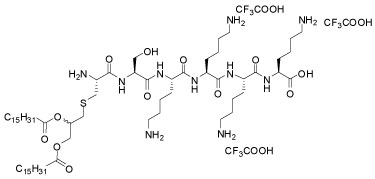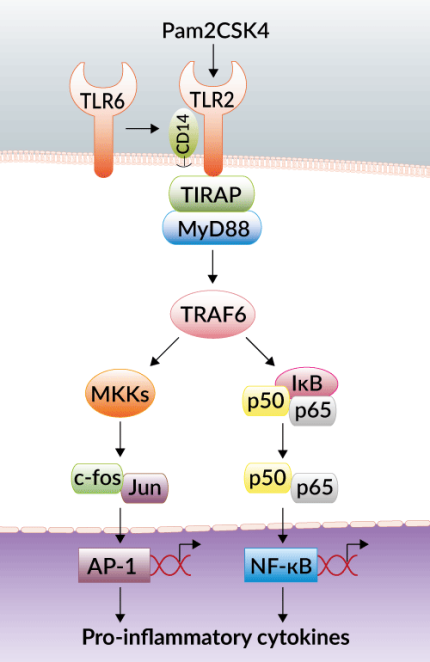Pam2CSK4
-
Cat.code:
tlrl-pm2s-1
- Documents
ABOUT
Synthetic diacylated lipopeptide
Pam2CSK4 (Pam2CysSerLys4) is a synthetic diacylated lipopeptide (LP) and a potent activator of the pro-inflammatory transcription factor NF-κB [1, 2]. Pam2CSK4 mimics the acylated amino terminus of bacterial LPs and is recognized by the TLR2/TLR6 heterodimer [2].
Mode of action:
At the cell surface, TLR2 forms a heterodimer with co-receptors TLR1 or TLR6, depending upon either tri- or diacylation of the ligand. Once a ligand binds to either TLR2-TLR1 or TLR2-TLR6, a MyD88-dependent activation of NF-κB and AP-1 occurs, ultimately leading to an innate immune response.
Recognition of Pam2CSK4, a diacylated lipoprotein, is mediated by TLR2 which cooperates with TLR6 through their cytoplasmic domain to induce a signaling cascade leading to AP-1 and NF-κB activation and cytokine production [2,3]. Of note, it has been demonstrated that Pam2CSK4 induces platelet activation in a TLR2/TLR6/NF-κB-dependent manner [1].
Key features of Pam2CSK4:
- Potent activator of the TLR2/TLR6 heterodimer
- Synthetic lipopeptide free of microbial contaminants
- Each lot is functionally tested
References:
1. Parra-Izquierdo I. et al., 2021. The Toll-Like Receptor 2 ligand Pam2CSK4 activates platelet nuclear factor-κB and Bruton's tyrosine kinase signaling to promote platelet-endothelial cell interactions. Front Immunol. 12:729951.
2. Kang J.Y. et al., 2009. Recognition of lipopeptide patterns by Toll-like receptor 2-Toll-like receptor 6 heterodimer. Immunity31(6):873-84.
3. Noh S.Y. et al., 2015. Lipoteichoic acid from Lactobacillus plantarum inhibits Pam2CSK4-induced IL-8 production in human intestinal epithelial cells. Mol Immunol . 64(1):183-9.
All products are for research use only, and not for human or veterinary use.
SPECIFICATIONS
Specifications
C65H126N10O12S • 3TFA
1 pg/ml - 10 ng/ml
1 mg/ml in water
TLR2 activity tested using HEK-Blue™ TLR2 cells, absence of endotoxins confirmed using HEK-Blue™ TLR4 cells
CONTENTS
Contents
-
Product:Pam2CSK4
-
Cat code:tlrl-pm2s-1
-
Quantity:1 mg
1.5 ml endotoxin-free water
Shipping & Storage
- Shipping method: Room temperature
- 4°C
- Avoid repeated freeze-thaw cycles
Storage:
Caution:
Details
TLR2
TLR2 plays a pivotal role in detecting a diverse range of pathogen-associated molecular patterns (PAMPs) from bacteria, viruses, fungi, and parasites [1].
Specifically, it recognizes cell-wall components including lipoproteins and peptidoglycan from bacteria, lipoteichoic acid from Gram-positive bacteria, lipoarabinomannan from mycobacteria, and zymosan from fungi. Notably, at the cell surface TLR2 forms a heterodimer with co-receptors TLR1 or TLR6, depending upon either tri- or diacylation of the ligand, respectively.
Downstream signaling of both TLR2 heterodimers has been shown to be enhanced when in association with CD14 [2]. Once a ligand binds to either TLR2-TLR1 or TLR2-TLR6, a MyD88- dependent activation of NF-κB and AP-1 occurs, ultimately leading to an innate immune response. Importantly, the ability for TLR2 to form heterodimers not only expands the range of PAMPs that it recognizes but can also lead to divergent responses depending on the heterodimer involved [3]. To date, TLR2 alone as a functional homodimer has only been proposed, with no evidence to prove that it triggers a signaling cascade [1].
Reference:
1. Oliveira-Nascimento L. et al., 2012. The Role of TLR2 in Infection and Immunity. Front Immunol. 3:79.
2. Lotz S. et al., 2004. Highly purified lipoteichoic acid activates neutrophil granulocytes and delays their spontaneous apoptosis via CD14 and TLR2. J Leukoc Biol. 75(3):467-77.
3. Nguyen M.T. et al., 2017. Lipid moieties on lipoproteins of commensal and non-commensal staphylococci induce differential immune responses. Nat Commun. 8(1):2246.
Chemical structure of Pam2CSK4:

DOCUMENTS
Documents
Technical Data Sheet
Safety Data Sheet
Certificate of analysis
Need a CoA ?

